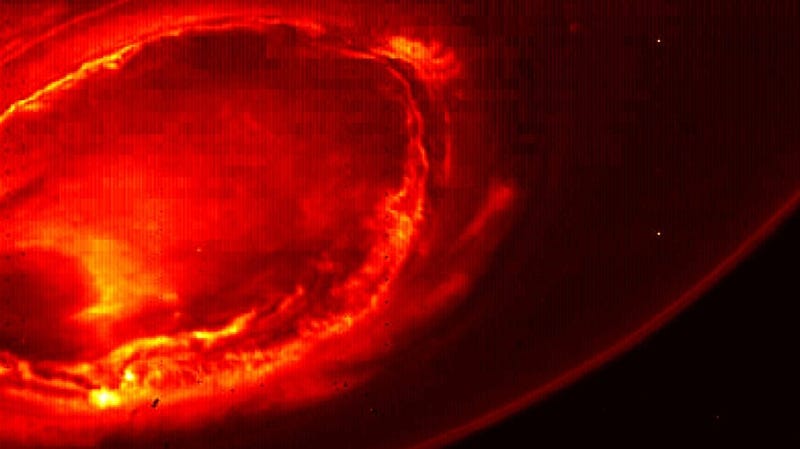 JIRAM image of Jupiter’s aurora. The big ring is from Io. Image: NASA/JPL-Caltech/SwRI/ASI/INAF/JIRAM
JIRAM image of Jupiter’s aurora. The big ring is from Io. Image: NASA/JPL-Caltech/SwRI/ASI/INAF/JIRAM
Despite being wildly different from Earth in almost every way, Jupiter does feature some familiar phenomena—including aurorae, what we call the Northern and Southern lights. But Jupiter’s aurorae have something Earth’s don’t: strange features caused by the Jovian moons.
Scientists analyzing data from the Juno spacecraft spotted some of these anomalies in action. They saw swirls and spots caused by Jupiter’s moons Io and Ganymede. And, as is often the case, things weren’t what they seemed from far away.
“It’s always surprising when you look at something closer,” Bertrand Bonfond, one of the study’s authors and an astronomer at the University of Liege in Belgium, told Gizmodo. “You always find small-scale features that are really surprising and unexpected. The closer you look, the more complex it appears.”
Jupiter’s aurorae, like Earth’s, are the result of charged particles hitting its atmosphere, producing a glow. In Jupiter’s case, the particles come from its magnetosphere, plasma surrounding the planet carried by its intense magnetic field. This plasma comes in part from its moon, Io—but Io’s magnetic field leaves its own mark on the aurora, too.
The researchers analyzed data from the Jovian Infrared Auroral Mapper (JIRAM) infrared camera and spectrometer on the Juno spacecraft. Think about magnetic fields as a set of instructions at every point in space that tell charged particles what to do. Io has a magnetic field line that connects the planet and the moon like beads on a hoop. As Io moves through the plasma and Jupiter’s magnetic field, it creates waves along this line that send electrons into Jupiter’s atmosphere.
Scientists have previously spotted the result of this behavior—a bright footprint in Jupiter’s aurorae that moved with Io. But they looked closer and saw what seems to be two trails or a squiggle of other spots—perhaps a secondary vortex effect, a trail left by the intersection of the two magnetic fields. The team also saw Ganymede leave spots in Juno’s aurorae, but did not see a trailing tail.
Jupiter isn’t the only planet whose moons cause disturbances in its aurorae—Saturn’s moon Enceladus leaves a similar footprint, according to the paper published in Science.
“These results are really interesting because it’s the first time that we’ve seen a double, or split, tail in the Io auroral footprint,” Marissa Vogt, postdoctoral fellow at the Boston University Center for Space Physics, told Gizmodo.
Results like these can help us understand the intense magnetic environment around Jupiter and other planets. “They provide valuable insight into the different magnetic field and plasma environments, or magnetospheres, that we see throughout the solar system,” said Vogt. “In this case, we’re learning new things about how the moons of Jupiter interact with the magnetosphere of Jupiter and how that interaction produces aurora on Jupiter.”
Bofond points out that, for now, the conclusions come from appearances alone—and they’ve haven’t been able to make a lot of other observations, yet. Now, he says, the scientists need to take all of the results from different instruments, put them together, and see if they really understand what’s happening.
[Science]